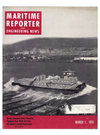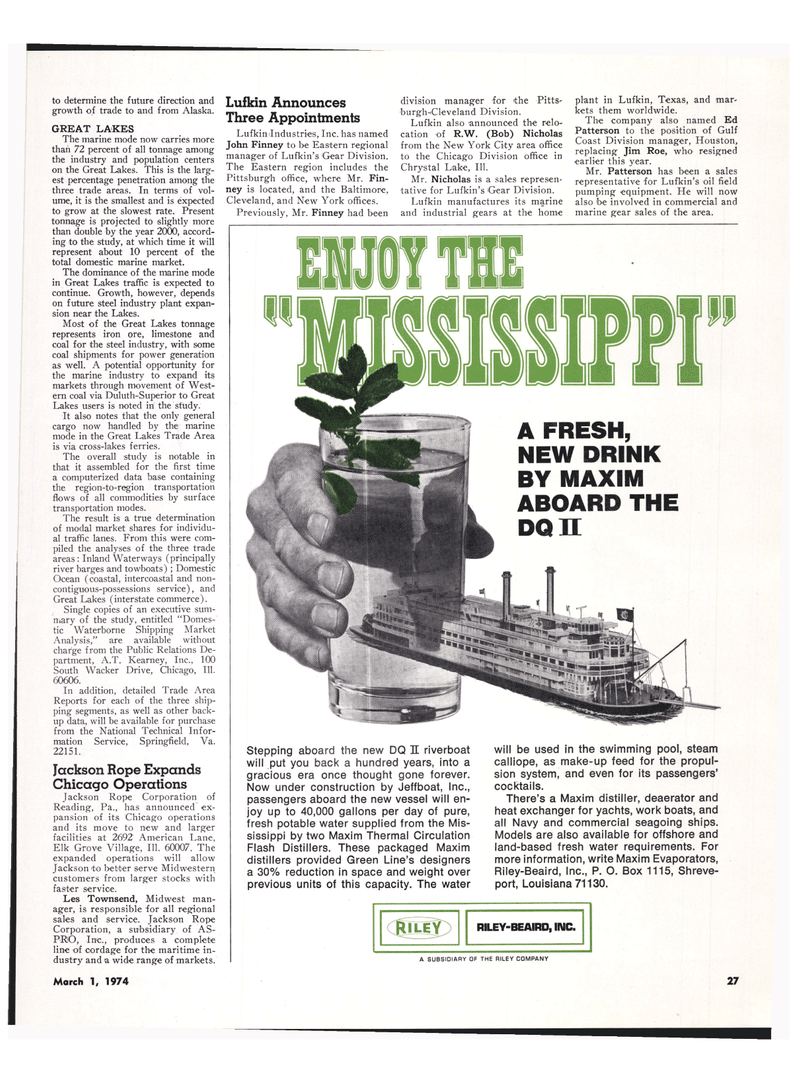
Page 23: of Maritime Reporter Magazine (March 1974)
Read this page in Pdf, Flash or Html5 edition of March 1974 Maritime Reporter Magazine
to determine the future direction and growth of trade to and from Alaska.
GREAT LAKES
The marine mode now carries more than 72 percent of all tonnage among the industry and population centers on the Great Lakes. This is the larg- est percentage penetration among the three trade areas. In terms of vol- ume, it is the smallest and is expected to grow at the slowest rate. Present tonnage is projected to slightly more than double by the year 2000, accord- ing to the study, at which time it will represent about 10 percent of the total domestic marine market.
The dominance of the marine mode in Great Lakes traffic is expected to continue. Growth, however, depends on future steel industry plant expan- sion near the Lakes.
Most of the Great Lakes tonnage represents iron ore, limestone and coal for the steel industry, with some coal shipments for power generation as well. A potential opportunity for the marine industry to expand its markets through movement of West- ern coal via Duluth-Superior to Great
Lakes users is noted in the study.
It also notes that the only general cargo now handled by the marine mode in the Great Lakes Trade Area is via cross-lakes ferries.
The overall study is notable in that it assembled for the first time a computerized data base containing the region-to-region transportation flows of all commodities by surface transportation modes.
The result is a true determination of modal market shares for individu- al traffic lanes. From this were com- piled the analyses of the three trade areas : Inland Waterways (principally river barges and towboats) ; Domestic
Ocean (coastal, intercoastal and non- contiguous-possessions service), and
Great Lakes (interstate commerce).
Single copies of an executive sum- mary of the study, entitled "Domes- tic Waterborne Shipping Market
Analysis," are available without charge from the Public Relations De- partment, A.T. Kearney, Inc., 100
South Wacker Drive, Chicago, 111. 60606.
In addition, detailed Trade Area
Reports for each of the three ship- ping segments, as well as other back- up data, will be available for purchase from the National Technical Infor- mation Service, Springfield, Va. 22151.
Jackson Rope Expands
Chicago Operations
Jackson Rope Corporation of
Reading, Pa., has announced ex- pansion of its Chicago operations and its move to new and larger facilities at 2692 American Lane,
Elk Grove Village, 111. 60007. The expanded operations will allow
Jackson to better serve Midwestern customers from larger stocks with faster service.
Les Townsend, Midwest man- ager, is responsible for all regional sales and service. Jackson Rope
Corporation, a subsidiary of AS-
PRO, Inc., produces a complete line of cordage for the maritime in- dustry and a wide range of markets.
Lufkin Announces
Three Appointments
Lufkin Industries, Inc. has named
John Finney to be Eastern regional manager of Lufkin's 'Gear Division.
The Eastern region includes the
Pittsburgh office, where Mr. Fin- ney is located, and the Baltimore,
Cleveland, and New York offices.
Previously, Mr. Finney had been division manager for the Pitts- burgh-Cleveland Division.
Lufkin also announced the relo- cation of R.W. (Bob) Nicholas from the New York City area office to the Chicago Division office in
Chrystal Lake, 111.
Mr. Nicholas is a sales represen- tative for Lufkin's 'Gear Division.
Lufkin manufactures its marine and industrial gears at the home plant in Lufkin, Texas, and mar- kets them worldwide.
The company also named Ed
Patterson to the position of Gulf
Coast Division manager, Houston, replacing Jim Roe, who resigned earlier this year.
Mr. Patterson has been a sales representative for Lufkin's oil field pumping equipment. He will now also be involved in commercial and marine gear sales of the area. am"
A FRESH,
NEW DRINK
BY MAXIM
ABOARD THE
DQH
Stepping aboard the new DQ II riverboat will put you back a hundred years, into a gracious era once thought gone forever.
Now under construction by Jeffboat, Inc., passengers aboard the new vessel will en- joy up to 40,000 gallons per day of pure, fresh potable water supplied from the Mis- sissippi by two Maxim Thermal Circulation
Flash Distillers. These packaged Maxim distillers provided Green Line's designers a 30% reduction in space and weight over previous units of this capacity. The water will be used in the swimming pool, steam calliope, as make-up feed for the propul- sion system, and even for its passengers' cocktails.
There's a Maxim distiller, deaerator and heat exchanger for yachts, work boats, and all Navy and commercial seagoing ships.
Models are also available for offshore and land-based fresh water requirements. For more information, write Maxim Evaporators,
Riley-Beaird, Inc., P. O. Box 1115, Shreve- port, Louisiana 71130.
RILEY RILEY-BEAIRD, INC. a SUBSIDIARY OF THE RILEY COMPANY
March 1, 1974 27

 22
22

 24
24
